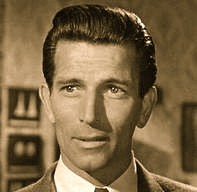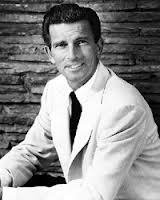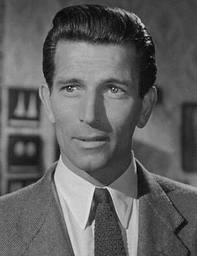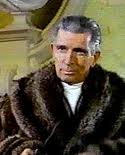Michael Rennie

Perry Mason: The Case of the Libelous Locket, Michael Rennie and Patrice Wymore
Perry Mason: The Case of the Libelous Locket, Season 6 – Episode 17, Special Guest Star: Michael Rennie. Janice Norland comes into Law Prof. Lindley’s office, saying she just killed a man and needs help. However, when they return to the scene, there is no body. When it develops into a case of blackmail, Janice’s stepmother, Maureen, comes to Prof. Lindley and asks for his help. With Perry in the hospital, he must undertake the defence when Janice is accused of murder. CAST: Raymond Burr as Perry Mason, Barbara Hale as Della Street, William Hopper as Paul Drake, William Talman as DA Burger, Wesley Lau as Lt. Andy Anderson, Patrice Wymore as Maureen Norland, Ruta Lee as Vivian Cosgrave, John Hoyt as Darwin Norland, Harry Von Zell as Sidney Hawes Patricia Manning as Janice Norland and Michael Rennie as Prof. Edward Lindley.
(born August 25, 1909 – died June 10, 1971) was an English-born film, television, and stage actor, perhaps best known for his starring role as the space visitor Klaatu in the classic science fiction film The Day the Earth Stood Still (1951). However, he also acted in more than 50 other films beginning in 1936. During the Second World War, Rennie served in the Royal Air Force. From 1959 onwards, Rennie also appeared in some American television series, in between acting in movies.
Early years
Eric Alexander Rennie was born in Idle near Bradford, West Riding of Yorkshire. He received his education at the Leys School, Cambridge. Rennie tried out a number of occupations, including periods as car salesman and as the manager of his uncle’s rope factory; before deciding (at the time of his 26th birthday, in 1935) on a career as an actor. Retaining his surname but adopting the professional name Michael Rennie, the 6′ 4″ tall show business hopeful, with chiseled facial features, first appeared onscreen in an uncredited bit part in the 1936 premiere of Sir Alfred Hitchcock‘s film Secret Agent.
During the late 1930s, Rennie served his apprenticeship as an actor, gaining experience in technique while touring the provinces in British repertory. There is evidence that, at the age of 28, he was noticed by one of the British film studios, which decided to appraise his potential as a film personality by arranging a screen test. The 1937 screen test, which exists in the British Film Institute archives under the title “Marguerite Allan and Michael Rennie Screen Test,” did not lead to a film career for either performer. In Secret Agent, he was primarily a stand-in for leading man Robert Young, and his on-camera sequence was so small that it cannot be discerned in the preserved final version of the film. He also played other bit parts, and minor unbilled roles in ten additional films produced between 1936 and 1940; the last of which, Pimpernel Smith, had a belated release in July 1941, when Rennie was already in uniform, serving in the Royal Air Force.
Shortly after the outbreak of war on 3 September 1939, Rennie began to receive offers for larger film roles, starting with his first (small) billed performance in the wartime morale booster The Big Blockade, seen in March 1940. Michael Redgrave, by then a fully-fledged star, had one of the leading roles in the film. Six films later, however, Michael Rennie also had his first film lead. The suspense drama Tower of Terror, released in late December 1941 was styled in the manner of a horror film, and it starred Wilfrid Lawson as a crazed Dutch lighthouse keeper in the Nazi-occupied Netherlands, while the second-billed Rennie and third-billed Movita had the romantic leads.
Michael Rennie enlisted in the RAF Volunteer Reserve on 27 May 1941 (Serial No 1391153). He was officially discharged on 4 August 1942, and then on the following day, he was commissioned “for the emergency” as pilot officer number 127347 on probation in the General Duties Branch of the RAFVR. On 5 February 1943, he was promoted to flying officer on probation. He resigned his commission on 1 May 1944 (not discharged on disability, as the studio publicity stated).
Rennie had carried out his basic training near Torquay in Devon, after which he was sent to the United States for fighter pilot training under the Arnold Plan. In this programme, pilots for the RAF were trained by United States Army Air Forces instructors. One of his fellow students was RAF Sgt Jack Morton, who told a humorous anecdote while he and Rennie were in the same class:
“At the end of our primary course we were posted to a Basic Flying School at Cochran Field, Macon, Georgia. The class which completed the course at Cochran Field was now split up, half were posted to Napier Field, Dothan, Alabama, to train on single engine planes, and the remainder were posted to twin-engine schools. Like Cochran, Napier Field was a large permanent Air Corps Base and most of us were quite content to stay on the camp when we had time off. One of the cadets on our course had told us that he was a film actor, but no one took him seriously. We had to admit that he was right however when a film came to the camp cinema called “Ships with Wings” starring Michael Rennie.”
British film star (1945–1950)
With the end of the war in Europe in May 1945, Rennie began to be seen as a potential star as a result of playing second leads in two vehicles for Britain’s most popular leading actress of the era, Margaret Lockwood: the musical I’ll Be Your Sweetheart and, most prominently, the sensual costume adventure The Wicked Lady. The latter turned out to be the year’s biggest box office hit, subsequently being listed ninth on a list of top ten highest-grossing British films. He also had a single prominent scene as a commander of Roman centurions in the film described at the time as the most expensive (and financially ruinous) British film enterprise ever made, Gabriel Pascal‘s production of George Bernard Shaw‘s Caesar and Cleopatra, starring Vivien Leigh and Claude Rains.
Second leads and then leads in seven other British films produced between 1946 and 1949 followed, including what may be considered Michael Rennie’s only role as one of two central characters in a fully-fledged love story. In the 47-minute episode “Sanatorium“, the longest of the Somerset Maugham tales constituting the omnibus film Trio (1950), the 40-year-old Rennie and the 20-years-younger Jean Simmons play patients in the title institution, which caters to victims of tuberculosis. They fall in love and decide to marry, despite the doctor’s grim prognosis that Rennie can only expect a few more months of life. Simmons’ character also faces a premature death within a couple of years.
Simmons would, in fact, turn out to be Rennie’s most frequent co-star. Although they shared no scenes in their minor roles in Caesar and Cleopatra (1945), it was the first of their films together. They also appeared in two 20th Century-Fox epics. In 1953’s The Robe and its 1954 sequel, Demetrius and the Gladiators, Rennie played the Apostle Peter, while Simmons portrayed a Christian martyr. In the sequel, they were only briefly seen in a flashback. Their final shared film was 1954’s Desiree. He was again billed fourth, after Marlon Brando (as Napoleon), Simmons (as the title character, Désirée Clary), and Merle Oberon (as Joséphine). Rennie’s character, French Marshal Jean-Baptiste Bernadotte, marries Désirée after Napoleon abandons her for Joséphine.
Rennie, along with Simmons and The Wicked Lady leading man James Mason, was one of a number of British actors offered Hollywood contracts in 1949–50 by 20th Century-Fox’s studio head, Darryl F. Zanuck. The first film under his new contract was the British-filmed Medieval period adventure The Black Rose, starring Tyrone Power, who became one of Rennie’s closest friends. Fifth-billed after the remaining first-tier stars Orson Welles, Cécile Aubry and Jack Hawkins, Rennie was specifically cast as 13th century King Edward I, whose 6′ 2″ (1.88 m) frame gave origin to his historical nickname “Longshanks”.
Rennie’s second Fox film gave him fourth billing in the top tier. The 13th Letter, directed by his future nemesis and love rival Otto Preminger, was a remake of the 1943 French film Le Corbeau (The Raven), with the setting changed to the Canadian province of Quebec. Rennie received top billing in his next film, after Claude Rains turned down the role. The Day the Earth Stood Still was the first post-war, respectably budgeted, “A” science-fiction film. It was a serious, high-minded exploration of Cold War paranoia and humanity’s place in the universe. The story was dramatised in 1954 for Lux Radio Theatre, with Rennie and Billy Gray recreating their roles. Seven years later, on 3 March 1962, when The Day the Earth Stood Still had its television premiere on NBC‘s NBC Saturday Night at the Movies, Rennie appeared before the start of the film to give a two-minute introduction.
Buoyed by the strong critical reception and profitability of the film, Fox assigned much of the credit to the central performance of Rennie. Convinced that it had a potential leading man under contract, the studio decided to produce a version of Les Miserables as a vehicle for him. The film, released on 14 August 1952, was directed by All Quiet on the Western Front‘s Lewis Milestone. Rennie’s performance was respectfully, but not enthusiastically, received by the critics. Ultimately, Les Misérables turned in an extremely modest profit and put an end to any further attempts to promote the 43-year-old Rennie as a future star. He was, however, launched on a thriving career as a top supporting actor, as in Sailor of the King. Based on the positive reaction to his two turns as the Apostle Peter, Fox assigned him another third-billed, top-tier role as a stalwart man of God, Franciscan friar Junipero Serra, who, between 1749 and his death in 1784, founded missions in Alta California. The film was September 1955’s Seven Cities of Gold, with Richard Egan and Anthony Quinn.
In 1953, he starred in Dangerous Crossing under contract with 20th Century Fox. It was released in 1953 as a black-and-white noirish mystery film. It was directed by Joseph M. Newman, starred Rennie and Jeanne Crain, and was based on a 1943 play Cabin B-13 by John Dickson Carr. The production reused sets and props from “Titanic” of the same year, in which Rennie did the closing narration. His next film was the last under his five-year contract with 20th Century-Fox. The Rains of Ranchipur, released on 14 December 1955, assigned him fifth billing after the lead romantic teaming of Lana Turner and Richard Burton. As Turner’s character’s cuckolded husband, Lord Esketh, Rennie maintained his typical dignity and stiff upper lip.
Now a freelancer, Rennie appeared in six additional features between 1956 and 1960, three of which were produced or released by Fox. Rennie appeared as adventurer Lord John Roxton in director Irwin Allen‘s 1960 adaptation of Sir Arthur Conan Doyle‘s The Lost World, a tale of a jungle expedition that finds prehistoric monsters in South America; the film also starred Claude Rains, David Hedison, Fernando Lamas, Jill St. John and Richard Haydn. No longer bound by the no-television clause in his studio contract, he began his prolific 15-year association with the medium.
The Third Man series and television
In 1959, Rennie became a familiar face on television, taking the role of Harry Lime in The Third Man, an Anglo-Americansyndicated television series very loosely based on the character previously played by Orson Welles. During the 1960s, he made guest appearances on such series as The Barbara Stanwyck Show, The Americans, Route 66 (a portrayal of a doomed pilot in the two-part episode “Fly Away Home”); Alfred Hitchcock Presents; Perry Mason (one of four actors in four consecutive episodes substituting for series star Raymond Burr, who was recovering from surgery); Wagon Train (a 90-minute colour episode as an English big game hunter); The Great Adventure (in an installment of this anthology series about remarkable events in American history, he portrayed Confederate president Jefferson Davis); Daniel Boone, (in the episodes “The Sound of Wings” and “First in War, First in Peace”); Lost in Space (another two-part episode—as an all-powerful alien zookeeper, “The Keeper”, he worked one last time with his Third Man costar Jonathan Harris); The Time Tunnel (as Captain Smith of the Titanic, in the series’ premiere episode); Batman (as the villainous Sandman, in league with Julie Newmar‘s Catwoman); three episodes of The Invaders (as a malign variation of the Klaatu persona, culminating in a parallel plot also involving an assembly of world leaders); an episode of I Spy (“Lana”); and two episodes of The F.B.I.
Broadway
At the start of the 1960s, Michael Rennie made his only Broadway appearance in Mary, Mary playing Dirk Winsten, a jaded film star. After two previews, the sophisticated five-character marital comedy written by Jean Kerr and directed by Joseph Anthonyopened at the Helen Hayes Theatre on 8 March 1961. It ran for a very successful 1,572 performances, closing at the Morosco Theatre on 12 December 1964. Rennie stayed with the production less than five months, to be replaced by Michael Wilding in July 1961.
When Warner Brothers Pictures cast the film version in early 1963, Rennie, along with leading man Barry Nelson and supporting actor Hiram Sherman (who joined the play two years after the opening in the part first played by John Cromwell) were the only Broadway cast members cast. Debbie Reynolds was given the title role created by Barbara Bel Geddes, and Warners contracteeDiane McBain, whom the studio saw as a potential star of the future, took over “the socialite part” essayed by Betsy von Furstenberg. Veteran Mervyn LeRoy produced and directed the film, which opened at Radio City Music Hall on 25 October 1963. Ironically, while the film disappeared from cinemas by the end of 1963, the Broadway version continued for another full year.
Rennie was married twice: first to Joan England (1938–1945), then to actress Margaret (Maggie) McGrath (1947–1960); their son, David Rennie, is an English circuit judge in Lewes, Sussex, England. Both marriages ended in divorce.
He also had a son, John Marshall, by his longtime friend and mistress, Renée (née Gilbert) whose later married name was Taylor. Renée was the sister of the British film director Lewis Gilbert. During the war years, they lived coincidentally in flats in the White House in Albany Street near Regents Park in London (now a hotel). The White House was a favourite location to live during the war years. It was built in the shape of a white cross and was such a good navigation mark for the Luftwaffe, that it was rumoured that there were standing orders to avoid bombing it – hence its popularity with celebrities and the wealthy.
Although Rennie offered to accept paternity on discovering the news of her pregnancy, Renée refused, as she was unwilling to jeopardise his growing success as a romantic lead in major feature films.
However, Rennie kept a watchful eye on Marshall over the years even after his marriage to Maggie McGrath and both families were in constant touch until Rennie’s death. In fact, Renée and Maggie lived for many years in the 1970s and 1980s within 200 yards of each other in Barnes and were close friends. Both Rennie and his sister Bunny were very fond of Renée’s family. Coincidentally the British Film Institute‘s database lists Michael as also having a son, John M. Taylor, who is described as “a producer.” John Marshall Rennie used the pseudonym “Taylor” during his long career in the industry to avoid accusations of nepotism.
Michael Rennie was also briefly engaged to Mary Gardner, the ex-wife of Hollywood director Otto Preminger.
After completing what amounted to guest roles in two 1968 films, The Power and The Devil’s Brigade, as well as top guest-starring roles in two episodes of the ABC/Quinn Martin Productions series The F.B.I., Michael Rennie moved from Los Angeles to Switzerland in the latter part of that year. His final seven feature films were filmed in Britain, Italy, Spain and, in the case ofSurabaya Conspiracy, the Philippines. Less than three years after leaving Hollywood, he journeyed to his mother’s home in Harrogate, Yorkshire, following the death of his brother. It was there that he died suddenly of a ruptured aortic aneurysm of the abdomen almost two months before his 62nd birthday. After his cremation, his ashes were laid to rest in Harlow Hill Cemetery, Harrogate.
Partial filmography
- Secret Agent (1936) (uncredited film debut)
- The Man Who Could Work Miracles (1936) (uncredited)
- Conquest of the Air (1936) (uncredited)
- The Squeaker (1937) (uncredited)
- Gangway (1937) (uncredited)
- The Divorce of Lady X (1938) (uncredited)
- Bank Holiday (1938) (uncredited)
- This Man in Paris (1940) (uncredited)
- The Briggs Family (1940) (uncredited)
- Dangerous Moonlight (1941)
- This Man Is Dangerous (1941)
- The Patient Vanishes (1941)
- “Pimpernel” Smith (1941) (uncredited)
- Turned Out Nice Again (1941) (uncredited)
- Ships with Wings (1941)
- Tower of Terror (1941)
- The Big Blockade (1942)
- I’ll Be Your Sweetheart (1945)
- The Wicked Lady (1945)
- Caesar and Cleopatra (1945)
- The Root of All Evil (1947)
- White Cradle Inn (1947)
- Idol of Paris (1948)
- Uneasy Terms (1948)
- The Golden Madonna (1949)
- Miss Pilgrim’s Progress (1950)
- Trio (1950)
- The Black Rose (1950)
- The 13th Letter (1951)
- The Day the Earth Stood Still (1951) – as Klaatu
- The Desert Fox: The Story of Rommel (1951) (uncredited narrator)
- The House in the Square, also known as I’ll Never Forget You (1951)
- Phone Call from a Stranger (1952)
- Five Fingers (1952)
- Les Misérables (1952) – as Jean Valjean
- Titanic (1953) (uncredited end narrator)
- The Desert Rats (1953) (uncredited narrator)
- Sailor of the King (1953)
- The Robe (1953) – as the Apostle Peter
- King of the Khyber Rifles (1953)
- Princess of the Nile (1954)
- Demetrius and the Gladiators (1954)
- Mambo (1954)
- Désirée (1954)
- Soldier of Fortune (1955)
- Seven Cities of Gold (1955)
- The Rains of Ranchipur (1955)
- Teenage Rebel (1956)
- Island in the Sun (1957)
- Omar Khayyam (1957)
- Battle of the V-1 (1958)
- Third Man on the Mountain (1959)
- The Lost World (1960)
- Mary, Mary (1963)
- Lost in Space (1965) – as The Keeper – two episodes
- Cyborg 2087 (1966)
- Batman (1966) – as The Sandman – two episodes
- Hotel (1967)
- The Power (1968) – as Arthur Nordlund/Adam Hart
- The Devil’s Brigade (1968) – as General Mark Clark
- Subterfuge (1968)
- Surabaya Conspiracy (1969)
- The Battle of Elalamein (1969)
- Los Monstruos del Terror, also known as Dracula vs. Frankenstein (1969/1970)







